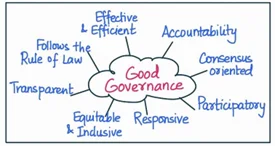Answer:
| Approach:
Introduction
Body
- Mention the examples for substantiating good governance.
- Various government initiatives in this regard.
Conclusion
- Conclude with the way forward and what more needs to be done.
|
Introduction:
Good governance refers to the effective and efficient management of public resources, institutions, and services to ensure that they are transparent, accountable, and responsive to the needs of the citizens. It involves a combination of sound policies, efficient public administration, and active participation of citizens in decision-making processes.

Body:
Recent initiatives in terms of e-Governance steps taken by the State have greatly helped the beneficiaries:-
- Digital Services: Initiatives like Digital India, e-Government Portals, and online platforms for service delivery have made government services more accessible to citizens.
- For example, the online portal for passport applications has streamlined the application process, reducing paperwork and long waiting times.
- Transparency and Accountability: Online platforms have enhanced transparency in government processes, making information readily available to the public.
- For example:- Initiatives like e-Tendering and e-Procurement have reduced corruption and favoritism in public procurement. The use of e-Governance in public financial management has improved accountability and reduced instances of financial irregularities.
- Citizen Engagement: E-Governance initiatives have provided platforms for citizen engagement and participation in decision-making processes.
- For instance, initiatives like MyGov.in allow citizens to contribute ideas, suggestions, and feedback on various policies and programs, promoting a more inclusive and participatory approach to governance.
- Online Grievance Redressal: The introduction of online grievance redressal portals in e-Governance.
- Example: Centralized Public Grievance Redress and Monitoring System (CPGRAMS) has made it easier for beneficiaries to register complaints and seek resolution.
- Efficient Service Delivery: E-Governance has improved the efficiency and speed of service delivery.
- For example, initiatives like Direct Benefit Transfer (DBT) enable the direct transfer of government subsidies and benefits to beneficiaries’ bank accounts, eliminating intermediaries and reducing leakages.
Conclusion:
e-Governance initiatives have significantly improved the efficiency and effectiveness of government services, increased transparency, reduced corruption, and enhanced citizen participation in decision-making processes. However, there is still much room for improvement, and it is important that the government continues to invest in and expand e-Governance initiatives to further improve public services and promote good governance.
